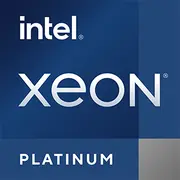Intel Xeon Platinum 8156

インテル Xeon Platinum 8156プロセッサーは、サーバープラットフォーム向けに設計された、強力で効率的なCPUです。 このプロセッサーは14nm技術で構築されており、要求の厳しいサーバーワークロードに対して高いパフォーマンスと信頼性を提供します。 4つのコアと8つのスレッドを持つXeon Platinum 8156は、複数のタスクを同時に処理できるため、マルチタスキングやリソース集約型のアプリケーションに適しています。
このプロセッサーの特徴の1つは、105Wのサーマルデザインパワー(TDP)であり、高いパフォーマンス能力にもかかわらずエネルギー効率を示しています。 これにより、データセンターやサーバー展開に費用対効果の高いソリューションとなり、全体的な電力消費量と運用コストを削減するのに役立ちます。
Xeon Platinum 8156に統合されたSkyLakeアーキテクチャと高度な技術は、最適なパフォーマンス、スケーラビリティ、および幅広いサーバーアプリケーションとワークロードのサポートを保証します。 クラウドコンピューティング、仮想化、またはハイパフォーマンスコンピューティングを支えるには、このCPUが必要な信頼性と処理能力を提供します。
全体として、Intel Xeon Platinum 8156プロセッサーは、パフォーマンス、効率、信頼性のバランスを提供するサーバー展開向けの最高級ソリューションです。その高度な機能と能力により、頑丈なサーバーパフォーマンスを必要とするビジネスや企業にとって確かな選択肢となります。
基本
レーベル名
Intel
プラットホーム
Server
発売日
July 2017
モデル名
?
Intel プロセッサーの番号は、コンピューティングのニーズに適したプロセッサーを選択する際に、プロセッサーのブランド、システム構成、システムレベルのベンチマークとともに考慮すべきいくつかの要素の 1 つにすぎません。
8156
コード名
SkyLake
CPUの仕様
コア合計数
?
コアとは、単一のコンピューティング コンポーネント (ダイまたはチップ) 内の独立した中央処理装置の数を表すハードウェア用語です。
4
スレッド合計数
?
該当する場合、インテル® ハイパー・スレッディング・テクノロジーはパフォーマンス・コアでのみ利用可能です。
8
基本周波数
3.60 GHz
最大ターボ周波数
?
最大ターボ周波数は、インテル® ターボ・ブースト・テクノロジー、およびインテル® ターボ・ブースト・マックス・テクノロジー 3.0 (存在する場合) およびインテル® サーマル・ベロシティ・ブーストを使用してプロセッサーが動作できる最大シングルコア周波数です。 周波数は通常、ギガヘルツ (GHz)、つまり 1 秒あたり 10 億サイクルで測定されます。
3.70 GHz
Intel Hyper-Threading Technology
?
Intel® Hyper-Threading Technology (Intel® HT Technology) delivers two processing threads per physical core. Highly threaded applications can get more work done in parallel, completing tasks sooner.
Yes
Intel Turbo Boost Technology
?
Intel® Turbo Boost Technology dynamically increases the processor's frequency as needed by taking advantage of thermal and power headroom to give you a burst of speed when you need it, and increased energy efficiency when you don’t.
2.0
Intel Turbo Boost Max Technology 3.0
?
Intel® Turbo Boost Max Technology 3.0 identifies the best performing core(s) on a processor and provides increased performance on those cores through increasing frequency as needed by taking advantage of power and thermal headroom.
No
ソケット
?
ソケットは、プロセッサとマザーボード間の機械的および電気的接続を提供するコンポーネントです。
FCLGA3647
製造プロセス
?
リソグラフィーとは、集積回路の製造に使用される半導体技術を指し、半導体上に構築されるフィーチャーのサイズを示すナノメートル (nm) で報告されます。
14 nm
消費電力
105 W
PCI Express バージョン
?
PCI Express リビジョンは、PCI Express 標準のサポートされているバージョンです。 Peripheral Component Interconnect Express (PCIe) は、ハードウェア デバイスをコンピュータに接続するための高速シリアル コンピュータ拡張バス規格です。 PCI Express のバージョンが異なれば、サポートされるデータ レートも異なります。
3.0
PCI Expressレーン数
?
PCI Express (PCIe) レーンは、2 つの差動信号ペア (1 つはデータ受信用、もう 1 つはデータ送信用) で構成され、PCIe バスの基本単位です。PCI Express レーンの最大数は、サポートされるレーンの合計数です。
48
Intel 64
?
Intel® 64 architecture delivers 64-bit computing on server, workstation, desktop and mobile platforms when combined with supporting software.¹ Intel 64 architecture improves performance by allowing systems to address more than 4 GB of both virtual and physical memory.
Yes
メモリ仕様
メモリタイプ
?
インテル® プロセッサーには、シングル チャネル、デュアル チャネル、トリプル チャネル、フレックス モードの 4 つのタイプがあります。 複数のメモリ チャネルをサポートする製品でチャネルごとに複数の DIMM を装着すると、サポートされる最大メモリ速度が低下する可能性があります。
DDR4-2666
最大メモリサイズ
?
最大メモリ サイズとは、プロセッサがサポートする最大メモリ容量を指します。
768 GB
最大メモリチャネル数
?
メモリ チャネルの数は、実際のアプリケーションの帯域幅動作を指します。
6
Maximum Memory Speed
2666 MHz
ECC Memory Supported
?
ECC Memory Supported indicates processor support for Error-Correcting Code memory. ECC memory is a type of system memory that can detect and correct common kinds of internal data corruption. Note that ECC memory support requires both processor and chipset support.
Yes
その他
Intel Virtualization Technology for Directed I/O (VT-d)
?
Intel® Virtualization Technology for Directed I/O (VT-d) continues from the existing support for IA-32 (VT-x) and Itanium® processor (VT-i) virtualization adding new support for I/O-device virtualization. Intel VT-d can help end users improve security and reliability of the systems and also improve performance of I/O devices in virtualized environments.
Yes
Intel Virtualization Technology (VT-x)
?
Intel® Virtualization Technology (VT-x) allows one hardware platform to function as multiple “virtual” platforms. It offers improved manageability by limiting downtime and maintaining productivity by isolating computing activities into separate partitions.
Yes
Intel Standard Manageability (ISM)
?
Intel® Standard Manageability is the manageability solution for Intel vPro® Essentials platforms and is a subset of Intel® AMT with out-of-band management over Ethernet and Wi-Fi, but no KVM or new life cycle management features.
Intel® SSE4.2 | Intel® AVX | Intel® AVX2 | Intel® AVX-512
Number of AVX-512 FMA Units
2
Enhanced Intel SpeedStep Technology
?
Enhanced Intel SpeedStep® Technology is an advanced means of enabling high performance while meeting the power-conservation needs of mobile systems. Conventional Intel SpeedStep® Technology switches both voltage and frequency in tandem between high and low levels in response to processor load. Enhanced Intel SpeedStep® Technology builds upon that architecture using design strategies such as Separation between Voltage and Frequency Changes, and Clock Partitioning and Recovery.
Yes
Execute Disable Bit
?
Execute Disable Bit is a hardware-based security feature that can reduce exposure to viruses and malicious-code attacks and prevent harmful software from executing and propagating on the server or network.
Yes
Cache
?
CPU Cache is an area of fast memory located on the processor. Intel® Smart Cache refers to the architecture that allows all cores to dynamically share access to the last level cache.
16.5 MB L3 Cache
Intel AES New Instructions
?
Intel® AES New Instructions (Intel® AES-NI) are a set of instructions that enable fast and secure data encryption and decryption. AES-NI are valuable for a wide range of cryptographic applications, for example: applications that perform bulk encryption/decryption, authentication, random number generation, and authenticated encryption.
Yes
Intel Volume Management Device (VMD)
?
Intel® Volume Management Device (VMD) provides a common, robust method of hot plug and LED management for NVMe-based solid state drives.
Yes
Intel VT-x with Extended Page Tables (EPT)
?
Intel® VT-x with Extended Page Tables (EPT), also known as Second Level Address Translation (SLAT), provides acceleration for memory intensive virtualized applications. Extended Page Tables in Intel® Virtualization Technology platforms reduces the memory and power overhead costs and increases battery life through hardware optimization of page table management.
Yes
ベンチマーク
Geekbench 6
シングルコア
スコア
962
Geekbench 6
マルチコア
スコア
5726
Geekbench 5
シングルコア
スコア
788
Geekbench 5
マルチコア
スコア
5678
他のCPUとの比較
Geekbench 6 シングルコア
Geekbench 6 マルチコア
Geekbench 5 シングルコア
Geekbench 5 マルチコア
ソーシャルメディアで共有する
または当サイトへのリンクを追加
<a href="https://cputronic.com/ja/cpu/intel-xeon-platinum-8156" target="_blank">Intel Xeon Platinum 8156</a>